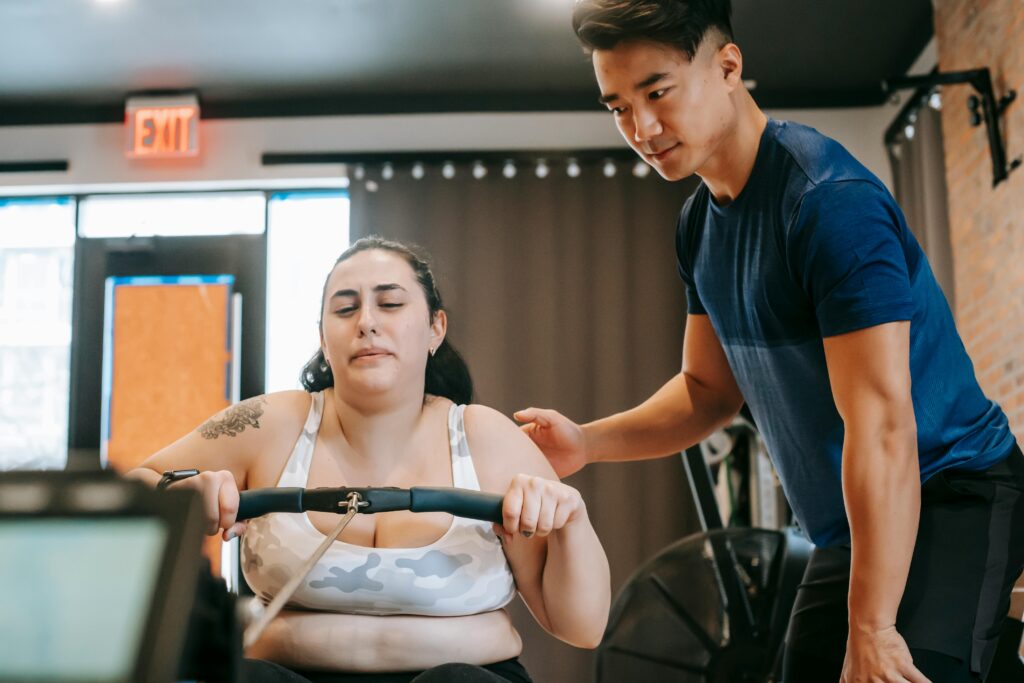Best gym plan to lose weight. Weight loss is often a problem in consumers’ focus; thus, having a clear and well-thought-out strategy with a gym will help achieve the goal. Besides enabling you to burn calories, a good gym plan allows you to develop muscles, hastens your metabolism, and enhances your health. In this guide, you will learn all about the most effective gym plan for losing weight and the different exercises and plans to follow. For anyone new to exercising or who has been practicing in the gym, this plan will help them lay a foundation for losing weight correctly. Wherever you work, travel, or visit, this plan can help start you on the road to a healthier you.
“Successful weight loss takes programming not willpower”
Dr. Phil McGraw
Understanding Weight Loss
To discuss the gym plan of the respective show, one has to familiarize oneself with some fundamental principles of weight loss. Losing weight is defined as an aim in which one uses up more calories than those they ingest. This deficit can be attained through a proper diet and the number of sets and reps a person performs. Like in any effective weight loss program, nutrition is a critical aspect, but exercise is equally important because it will allow the burning of calories and the building of muscles.

Components of a Successful Gym Plan
When drawing up a weight loss plan for a gym, one should consider the type, intensity, frequency, and duration of cardio exercises, strength exercises, and Flexibility exercises to be done. Thus, each component contributing to the program matrix aims to support your goal to shed some extra pounds and get fit.
1. Cardio Exercises
Cardiovascular exercises are crucial for burning calories and enhancing cardiovascular health. They raise the pitch of your heart and assist you in losing fat.
Examples of effective cardio exercises include:

- Running or Jogging: Generally, a proper diet, running on a treadmill, and circling a specific track will positively impact a person’s calorie expenditure.
- Cycling: This one is very effective on a stationary bike or the actual cycling machine; it is perfect for the heart and calories.
- Elliptical Trainer: This low-impact machine allows users with joint problems to work out huge muscles effectively.
- Rowing Machine: Rowing mainly involves the pulling of muscles and is very extensive in terms of cardiovascular exercise.
2. Strength Training
In other words, strength training measures aim to increase the MET level by developing the necessary muscular tissue. Skeletal muscle is more metabolically active than fat tissue; therefore, the more muscle, even if the person is just a layman, the higher the number of calories used. Effective strength training exercises include: Effective strength training exercises include:

- Weightlifting: Weight training is good for the body because it increases muscle mass and stiffness. For the alternative plan, very strong emphasis should be put on compound movements such as squats, deadlifts, bench presses, and rows.
- Bodyweight Exercises: Chin-ups, push-ups, leg pushes, squats, and other abdominal crunches are also effective strength-building activities that can be done without apparatus.
- Resistance Bands: These trainers are multifunctional, enabling one to perform various strength exercises, and are ideal for building different muscle groups.
- Machines: Performing gym exercises helps to target muscles and perform the exercises under set conditions.
3. Flexibility and Mobility
While formulating your gym plan, flexibility and mobility exercises are useful to avoid injuries, increase the extent of moving parts, and improve performance. Examples include:

Stretching: It is widely known that stretching strengthens the muscles and enhances Flexibility, resulting from their habitual construction and permanent stiffness.
Yoga: Yoga provides psychological advantages in addition to improving Flexibility and balance in the body.
Foam Rolling: It assists in eliminating pressure in the muscles and offers enhanced movement to your muscles.
“For me, exercise is more than just physical-it’s therapeutic.”
Michelle Obama
The Best Gym Plan to Lose Weight
The following gym plan contains several exercises covering cardio, strength, and flex, strictly following the principles of balanced fitness. It can be modified depending on the fitness level and the participants’ end goals. Ensure they work out at least five days per week and incorporate the above aspects.
Day 1: Cardio and core

Warm-up: 5 to 10 minutes of walking, with swift walking equivalent to 5 to 10 minutes of jogging.
Cardio Workout: 30 minutes of running on the treadmill or cycling-equivalent.
Core Workout:
Planks: increase the sets by 30 seconds to three sets.
Russian Twists: 3 sets of 15 reps
Leg Raises: 3 sets of 12 reps
Bicycle crunch- five exercises consisting of 3 sets of 15 repetitions on the right side of the body and another three sets of 15 repetitions on the left side.
Cool Down: The stretching should last 5-10 minutes to be effective.
Day 2 :
Day two is characterized as Upper Body Strength, which includes push-ups, chin-ups, dips, and shoulder presses.
Warm-up: Five minutes of aerobic exercise, which should not be intense, followed by five to ten minutes of intense training.
Strength Training:
Bench Press: Three sets with repetition ranging from 8-12.
Dumbbell Rows: It is recommended that the patients perform three sets of 8-12 repetitions.
Shoulder Press: Four exercises are practically sets of 8-12 repetitions.
Bicep Curls: Three groups that contain 12-15 reps.
Triceps Dips: Three to four sets of 12 to 15 reps
Core Workout:
Side Planks: This is three cycles of 30 seconds per side.
Mountain Climbers: 3 sets of 20 each on the opposite side
Cool Down: Therefore, 5-10 minutes of stretching can or should be included before exercise.
Day 3: Cardio and Lower Body
Warm-up: 5-10 minutes of light warm-up exercises, including light jogging on the treadmill and the belt.
Cardio Workout: steady exercising on an elliptical or a rowing machine, for instance, should only take 15 to 30 minutes at most.
Lower Body Strength:
Squats: Three groups of exercises are generally in the 12-15 repetition range.
Deadlifts: These are long sets of exercises that a person can repeat between 8 and 12 times, about three sets.
Lunges: 12 repetitions in 3 sets, each for legs.
Leg Press: 3 approaches to sets of repetitions to be done: 12-15 repetitions each.
Calf Raises: This study includes three sets with 15 repetitions of the exercises.
Cool Down: Some exercises take a few minutes, others take 5-10 minutes: stretching.
Day 4: Active rest and Flexibility
Light Activity: Try walking, doing yoga, or doing light exercise—anything that will help get your blood flowing.
Flexibility Workout:
Full body stretching routine
Self-myofascial release for muscles
Day-5:
Full Body Strength and HIIT workout during the 5th day of the training program.
Warm-up: About 5-10 minutes of moderate activities, including jogging or brisk walking.
Strength Training:
Deadlifts: There are three series of 8 to 12 repetitions.
Pull-ups or Lat Pulldowns: 3 sets for each exercise of 8-12 reps
Overhead Press: Performing 8-12 exercise reps in 3 sets is recommended.
Step-ups: 12 reps, three sets per leg
HIIT Workout:
It consists of twenty seconds of exercises, such as burpees and jump squats. The work interval is 20 seconds, and then the subject has a break for 10 seconds.
Repeat for 4 minutes.
Do three sets of the circuit, then take a one to two-minute rest before repeating the circuit.
Cool Down: To develop Flexibility, one should stretch for 5-10 minutes.
Day 6: Cardio & Core
Warm-up: It will not take a long time of 5 to 10 minutes of light cardio.
Cardio Workout: Interval Running for 30 minutes, sprinting for 1 minute, and walking for an additional 2.
Core Workout:
Ab Wheel Rollouts: Three sets of ten attempts
Three sets of twelve reps for front raises using a pull-up bar.
Reverse Crunches: This set of patterns consists of 3 repetitions, with each attack repeated 15 times.
Flutter Kicks: 20, each leg, three sets
Cool Down: Baffled and bewildered are the students who expect a doze after the 5-10 minutes of stretching.
Day 7: Lounging Around
Active Rest: It is recommended to perform light activities like walking or doing basic yoga or stretches.
Recovery: Ensure you supplement the body with a balanced diet and water to rest adequately after exercise.
Stay Consistent
One thing that exercise is not is an event, and sustaining it is therefore central to achieving weight loss goals. If you have defined some goals for the workouts, ensure that you adhere to the set goals even if you do not feel like exercising at the gym. In the way the illustration connects to the topic throughout the illustration, the author makes it evident that, for example, even though taking a jog, say, burns a lot of time, it is going to yield a better result than taking a replica that does not take so long to produce.
- Track Your Progress

Keep a personal record of your workouts, the weight you plan to lose, and other bodily changes in a workout journal or using an app. It is good to have milestones and check your progress to know the outcomes and prospects concerning your goals.
- Mix It Up
Do not repeat the same exercise; it will be boring, so always combine your workouts. Mix up the type of exercises, programs, and methods to make the workout experience new and more intense. Not only does variety help eliminate boredom, but you are targeting different muscles at the same time.
- Keep properly hydrated and Balanced Diet.
This shows that exercise does not help with weight loss by itself. Thus, do not forget to eat a balanced meal and drink enough water during your exercise regimen. Nutrition gives your body the energy required to perform optimally, ‘the right food for the right job.’
- Get Enough Sleep
Sleep is very important for the body to recover and maintain good health. Sleep between 7 and 9 hours to support your intention of losing weight and also to have energy for exercise.
- Listen to Your Body
However, it is also necessary to listen to the body to avoid soreness or injury that results from stretching one’s capabilities too much. Any fitness program should include rest and recovery. If you feel that muscles are stiff or perhaps tired, you can rest during the day or switch to a less intensive workout.
Conclusion
The best gym plan to lose weight includes three fundamental elements: cardio sessions, strength training, and Flexibility. If you consistently follow the strategies in this guide, you will shed excess weight and enhance your fitness. These are the resolutions; wherever you are, you can use this plan to become healthier and fit.
Remember that you are trying to lose weight, which will take some time rather than a few days. It takes time to trim off a few extra pounds ‘and ‘it also takes time to add on a few extra pounds, so take your time. If you want a proper gym plan, pay attention and choose the program. You will get the required results and take advantage of several worthwhile benefits. Hence, wear your exercise shoes, go to the gym or trainer, and start your change process with a new person today.



